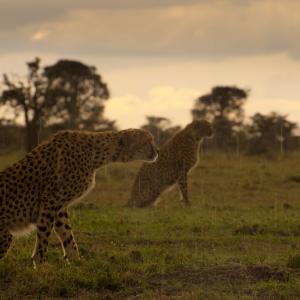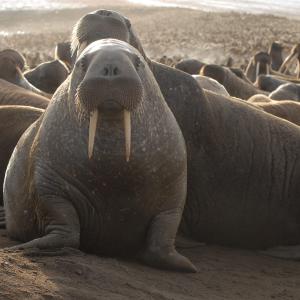1. How did you film this sequence?
Filming these sorts of scenes is never easy and this was a particularly emotional one.
Walruses as you can imagine are frightened of people, something that we were exceptionally mindful of when filming them. When approaching the walruses we made sure we were downwind of them and that we could not be seen. We only stood up when it was safe to do so and when we weren't at risk of scaring any walrus. Sometimes that meant crawling in on our bellies and using whatever cover we could find to hide ourselves. It could take over an hour for us to get in position, but it was worth it to have peace of mind that we were not disturbing the walrus by approaching slowly and extremely cautiously.
2. Did you take any special measures to make sure you didn’t disturb the animals?
We had a scientist with us at all times (Anatoly Kochnev, Russian Academy of Sciences, whose work studying walrus behaviour in Russia is supported by WWF) monitoring us and making sure that we did not disturb the walruses. If on occasion Anatoly could not be with us, then he provided us with one of his trusted field biologists who were also there to study the walrus.
Before filming, Anatoly briefed us on how to behave around walrus and we agreed that we would only position ourselves where he thought we would not disturb the walrus. Anatoly specified the best/safest spots to film from and we adhered to his instruction. At the cliff site, we did not get closer than about 50m to the walrus. At the mass haul out site, where the walrus surrounded the cabin, we only attempted to film outside the cabin when Anatoly deemed it safe to do so and he monitored us at all times and limited how long we could be outside the cabin. The walruses were inquisitive of us but we were extremely careful when moving, doing so very slowly and careful not to break the "line" of the cabin.
3. Why did the walrus climb the cliffs? And why did they throw themselves off it?
The exact reasons behind why walrus climb cliffs is hard to pin down, however we saw walrus climb up when there was no more space on the beach below. Once the area below the cliffs was full, they spread out around and eventually up the cliffs and the majority were unable to find their way safely down, with tragic consequences.
It is important to remember the long-term context of this situation. Anatoly has been monitoring these Russian coastal sites for 35 years. These long-term observations reveal that in recent years (especially the last 10 years) walrus are coming ashore to rest much more frequently now than they did in the past and at some sites, in much larger numbers and especially females with their calves. This is because of sea ice loss, which is caused by climate change. It is important to note, that this research pertains to pacific walrus, which are the ones we filmed for the sequence.
4. What was it like filming this sequence?
Filming the devastating scenes of walruses falling were some of the most emotional I’ve ever encountered. There was a real sense of utter heartbreak, horror and helplessness. Initially we couldn’t fathom how/why there were climbing the cliffs, it was incredibly hard to watch and witness it happen.
Our role as documentary filmmakers is to observe and keep the correct distance from the animals being filmed, so we felt like we couldn’t intervene. There is nothing we could have done to have stopped the walrus and if this tragic situation led to self-reflection and the belief that the best thing we could do is to educate people on the impact climate change is having on the sea-ice then I hope this awareness helps us all to reduce carbon emissions.
5. What message do you have for people who have seen this?
The big picture is the important message. Ultimately, several hundred walrus may die because of the cliff situation, but many thousands because of sea-ice loss and climate change. I urge anyone who has been affected by these scenes to go to OurPlanet.com and find out how you can help to tackle climate change.
 Our reports in the knowledge hub
Our reports in the knowledge hub
 Here are our top 10 facts about Walrus
Here are our top 10 facts about Walrus